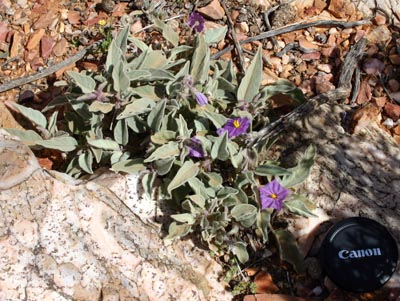


 |
 |
|
|||||
 |
|||||||
| |
|
|
|
|
|
||
|
|
|
|
|
|
|
|
|
|
Solanum ellipticium
velvet potato bush Plants from the Solanaceae family occur throughout Fowlers Gap, commonly on rocky outcrops but also on the alluvial and colluvial plains in the shelter of larger plants. These are commonly referred to as "Nightshades", the worst being Deadly Nightshade, common in Europe and infamously used to poison the troops of Marcus Antonius during the Parthian wars, and was used by Scots soldiers of Duncan the 1st to poison invading Danes, allowing them to be murdered in their sleep! The most common solanum at Fowlers Gap is the velvet potato bush (Solanum ellipticum), also called the velvet nightshade or tomato bush. The fruits of some of the native Solanaceae are edible after the removal of seeds, drying and/or roasting. Extreme care must be taken to not confuse the edible velvet potato bush with the DEADLY wild tomato (Solanum quadriloculatum), which looks similar but is definitely NOT edible. Best to not even try it. Other Solanaceae that occur at Fowlers Gap include the S. esuriale (quenna) and S. nigrum (black-berry nightshade). The velvet potato bush is a low sprawling herb under 20
cm high and 15-100 cm across. |
 |